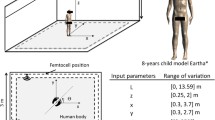Abstract
Experimental dosimetry of electromagnetic fields (EMFs) in biological tissue is important for validating numerical techniques, designing electromagnetic exposure systems, and compliance testing of wireless devices. Compliance standards specify a two-step procedure to determine the peak spatial-averaged SAR in 1 g or 10 g of tissue in which the measurement locations lie on a rectilinear grid (selected up-front). In this chapter, we show the potential of surrogate modeling techniques to significantly reduce the duration of experimental dosimetry of EMF by using a sequential design. A sequential design or adaptive sampling differs from a traditional design of experiments as data and models from previous iterations are used to optimally select new samples resulting in a more efficient distribution of samples as compared with the traditional design of experiments. Based on a data set of about 100 dosimetric measurements, we show that the adaptive sampling of surrogate modeling is suitable to speed up the determination of the peak SAR location in an area scan by up to 43 and 64% compared with the standardized area scan on a rectilinear grid (IEC 622090, IEEE Std 1528:2013) for the LOLA-Voronoi-error and the LOLA-max surrogate model, respectively.
Access this chapter
Tax calculation will be finalised at checkout
Purchases are for personal use only
Similar content being viewed by others
References
CENELEC (2016) Measurement procedure for the assessment of specific absorption rate of human exposure to radio frequency fields from hand-held and body-mounted wireless communication devices—Part 1: Devices used next to the ear (Frequency range of 300 MHz to 6 GHz). EN:62209-1
CENELEC (2010) Human exposure to radio frequency fields from hand-held and body-mounted wireless communication devices—Human models, instrumentation, and procedures—Part 2: Procedure to determine the specific absorption rate (SAR) for wireless communication devices used in close proximity to the human body (frequency range of 30 MHz to 6 GHz). EN:62209-2
IEEE (2013) IEEE recommended practice for determining the peak spatial-average specific absorption rate (SAR) in the human head from wireless communications devices: measurement techniques. IEEE Std 1528-2013
Douglas M, Capstick M, Kainz W, Kuster N (2015) Validation of emerging fast SAR measurement technologies. In: The annual meeting of bioelectromagnetics society and European bioelectromagnetics association, Pacific Grove, California, USA, 14–19 June 2015
Gorissen D, Couckuyt I, Laermans E, Dhaene T (2010) Multiobjective global surrogate modeling, dealing with the 5-percent problem. Eng Comput 26(1):81–98
Wang GG, Shan S (2007) Review of metamodeling techniques in support of engineering design optimization. J Mech Des 129(4):370–380
Vermeeren G, Singh P, Aerts S, Deschrijver D, D’Haene T, Joseph W, Martens L (2015) Surrogate-based fast peak mass-averaged SAR assessment. In: The annual meeting of bioelectromagnetics society and European bioelectromagnetics association, Pacific Grove, California, USA, 14–19 June 2015
Crombecq K, De Tommasi L, Gorissen D, Dhaene T (2009) A novel sequential design strategy for global surrogate modeling. In: Proceedings of the 2009 winter simulation conference (WSC), Austin, TX, USA. https://doi.org/10.1109/WSC.2009.5429687, pp 731–742
Gorissen D, Crombecq K, Couckuyt I, Dhaene T, Demeester P (2010) A surrogate modeling and adaptive sampling toolbox for computer based design. J Mach Learn Res 11:2051–2055
van der Herten J, Couckuyt I, Deschrijver D, Dhaene T (2016) Adaptive classification under computational budget constraints using sequential data gathering. Adv Eng Softw 99:137–146
Acknowledgements
The authors of this chapter would like to thank prof. Niels Kuster and Dr. Esra Neufeld from IT’IS Foundation (Zürich, Switzerland) and Jan Lienemann from SPEAG (Zürich, witzerland) for their support in this study.
Author information
Authors and Affiliations
Corresponding author
Editor information
Editors and Affiliations
Rights and permissions
Copyright information
© 2019 Springer Nature Switzerland AG
About this chapter
Cite this chapter
Vermeeren, G., Joseph, W., Martens, L. (2019). Surrogate Modeling for Fast Experimental Assessment of Specific Absorption Rate. In: Canavero, F. (eds) Uncertainty Modeling for Engineering Applications. PoliTO Springer Series. Springer, Cham. https://doi.org/10.1007/978-3-030-04870-9_5
Download citation
DOI: https://doi.org/10.1007/978-3-030-04870-9_5
Published:
Publisher Name: Springer, Cham
Print ISBN: 978-3-030-04869-3
Online ISBN: 978-3-030-04870-9
eBook Packages: Intelligent Technologies and RoboticsIntelligent Technologies and Robotics (R0)




